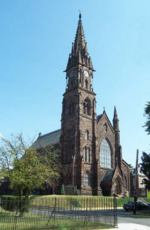St. Mark's Episcopal Church (West Orange, New Jersey)

St. Mark's Episcopal Church is a historic church located at 13 Main Street at Valley Road in West Orange, Essex County, New Jersey, United States. After the Episcopal congregation dwindled, the building subsequently housed the Primera Iglesia Evangelica Metodista Libra de los Oranges, a Methodist congregation. The building's interior was destroyed, and exterior badly damaged, by fire on January 1, 2016.The church was called an "outstanding example of Gothic Revival architecture" by Preservation New Jersey, and was listed as one of the ten most endangered historic sites in New Jersey in 1996. It has been said that the building "represents the beginning and the end of the ecclesiological style in the United States." The Ecclesiological style movement in church architecture advocated Gothic revival architecture using theological arguments.
Excerpt from the Wikipedia article St. Mark's Episcopal Church (West Orange, New Jersey) (License: CC BY-SA 3.0, Authors, Images).St. Mark's Episcopal Church (West Orange, New Jersey)
Main Street,
Geographical coordinates (GPS) Address Nearby Places Show on map
Geographical coordinates (GPS)
| Latitude | Longitude |
|---|---|
| N 40.776944444444 ° | E -74.238888888889 ° |
Address
Main Street
07052
New Jersey, United States
Open on Google Maps








